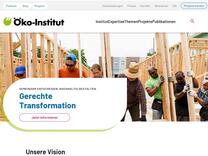Konzept zur absoluten Verminderung des Energiebedarfs: Potenziale, Rahmenbedingungen und Instrumente zur Erreichung der Energieverbrauchsziele des Energiekonzepts | oeko.de https://www.oeko.de/publikation/konzept-zur-absoluten-verminderung-des-energiebedarfs-potenziale-rahmenbedingungen-und-instrumente-zur-erreichung-der-energieverbrauchsziele-des-energiekonzepts/
Die Studie untersucht verhaltensbedingte Maßnahmen zur absoluten Energieeinsparung in Haushalten, die zusätzliche Einsparungen gegenüber bestehenden Szenarien, insbesondere „Politikszenarien VI“ erbringen könnten. Der Beitrag zu den Zielen des Energiekonzeptes wird abgeschätzt; dabei werden sowohl Investitionsverhalten als auch Nutzungsverhalten betrachtet. Da die meisten Effizienzmaßnahmen bereits in anderen Szenarien behandelt wurden, liegt ein weiterer Fokus auf Suffizienz. Analysiert werden die Bedürfnisfelder Bauen und Wohnen, Geräte, Mobilität und Ernährung sowie das Handlungsfeld Schule und Arbeitsplatz.
Hannah Förster Gruppenleiterin Mitigation & Ökonomie / Senior Researcher Energie

